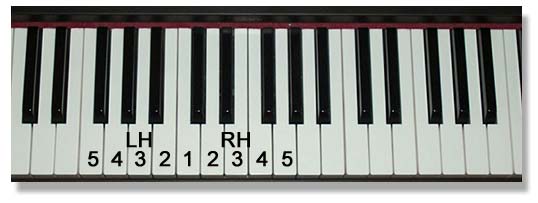
Middle C Position
Here we will look (and play) the "C Major Scale". The reason we will start with this particular scale is because this scale has no "Sharps or Flats". So this scale will only use the "white keys". If using a metronome, set the B.P.M. (beats per minute) or speed to "60". This means there are sixty beats per minute (or one per second) as a start.

Middle C Position
|
C Scale Right Hand |
|
|
C Scale Right Hand |

Let's start with the right hand, so first assume the correct position, and place your right thumb on the note "C". Play the note with your (thumb) "one finger" and hold it for four beats then release. Using your (index) "second finger" play and hold the "D" for four beats. Your third finger will play (and hold) the "E" for four beats. Now (without letting your wrist out of position) moves your "one" (or thumb) underneath the "three" (or middle finger) and play the "F" note (and hold and count four beats.) Your "second" finger will now play the "G" note (hold and count for four beats.) Your "three finger" (middle finger) will now play the "A" note (hold and count four beats.) Your "fourth" finger will play the "B" and your ('pinky') "five" finger will play the "C" note (hold and count four beats and then release.)
You have just played the C Major Scale! It may seem tedious right now to go so slow and count each note for so long. However, this is a good way to introduce your hands to proper fingering (and dexterity training) while familiarizing yourself with a proper sense of timing. Remember, accuracy first and speed later. If you find that this speed is uncomfortable go even slower because rushing yourself will only cause unwanted (and unnecessary) frustration.

Piano notes used in the key of C
|
C Scale Left Hand |
|
|
C Scale Left Hand |

Now let's play this scale with the left hand. Assume the correct position and with your "five" finger (or 'pinky') play the "C" note (hold and count for four beats then release.) Your "fourth" finger will play the "D" (hold and count for four beats.) Your "third" finger will now play the "E" (hold while counting then release.) Your "two" finger (or index) will now play the "F" (hold while counting then release.) Your "One" finger (the thumb) will play the "G" (hold while counting then release.) Now without letting your wrist move out of position, let the "third" finger move overtop of the "One" and play the "A" note (hold while counting then release.) Your "second" finger (index) will now play the "B" note (hold and count for four beats.) and then let your "One" finger (thumb) play the "C" (hold and count for four beats and release.)
Play this scale this way (ascending motion) until you feel comfortable and if desired turn your metronome up one (or two) bpm and repeat. I know what you’re thinking... "this is too slow and tedious" but trust me, this method is used not only for instruction for beginners but a way for 'experienced' players to assist themselves in memorizing songs faster (than just straight repetition.)
Before we move on, we will look at the "Major Scale Pattern". This is the same pattern for the "C" (and the other eleven) Major scales.
This scale pattern is:
| C - D | D - E | E - F | F - G | G - A | A - B | B - C |
|---|---|---|---|---|---|---|
| Tone | Tone | Semi-tone | Tone | Tone | Tone | Semi-tone |
From any note to the next letter name of a natural note is one tone except from B-C and E-F, which are semi-tones.
, B-C= semi-tone, , , E-F= semi-tone, ,
The two semi-tones appear between the second and third notes of the scale as well as the seventh and eighth notes. (The eighth note is the same as the first note and can be referred to as either. It is a better practice to call the last note "one" because the term "eighth note" can be confused with type of note described earlier.)
A tone is made up of two semi-tones. So the first tone from C to D is a tone because it passes over the C sharp (or one black note.) D to E is a Tone because it encompasses the D sharp. However, E to F is semi-tone because there is no other note in-between these two notes. F to G, G to A and A to B are all tones but the last two notes being B to C is another semi-tone.